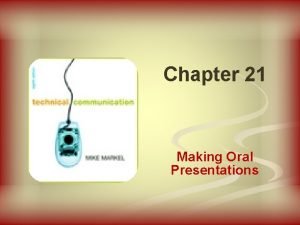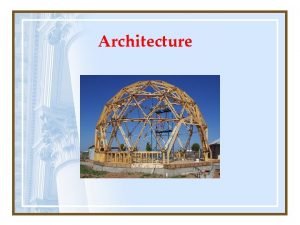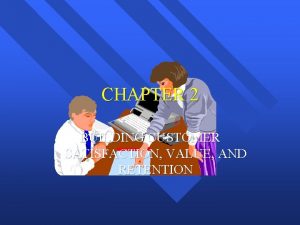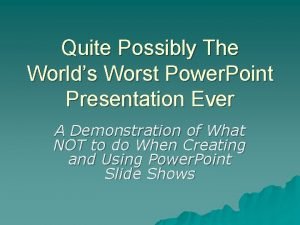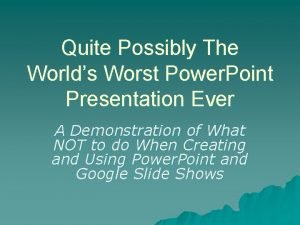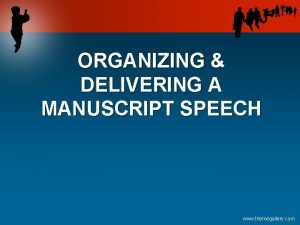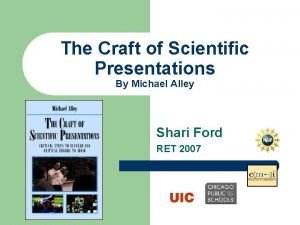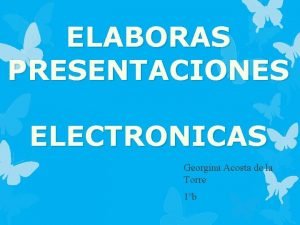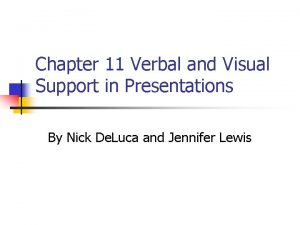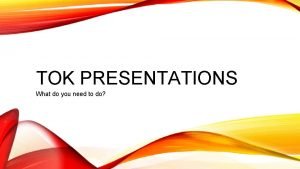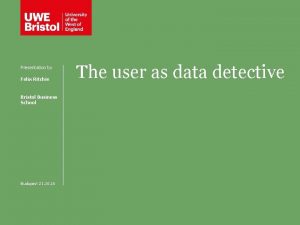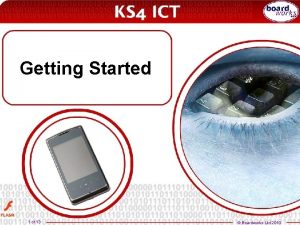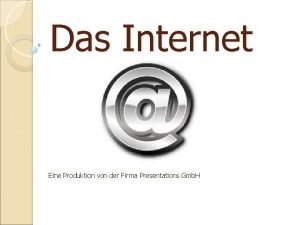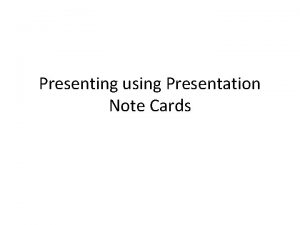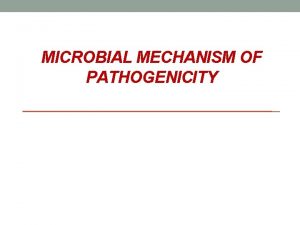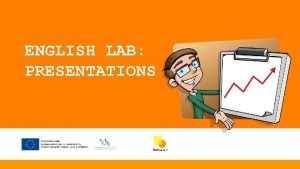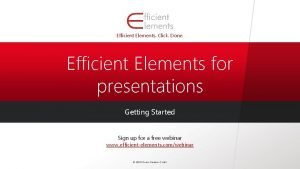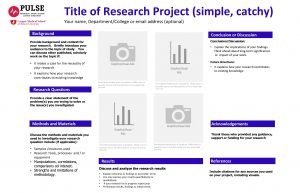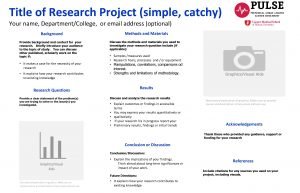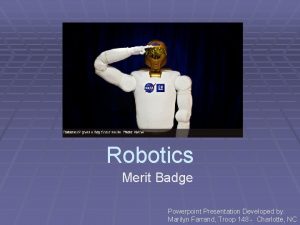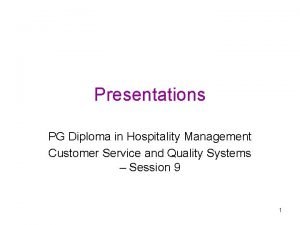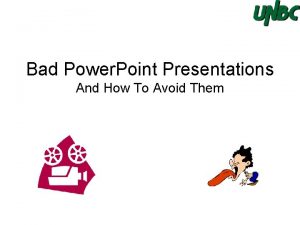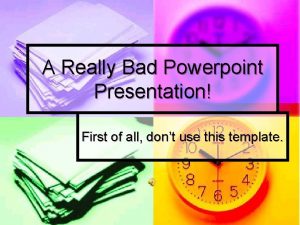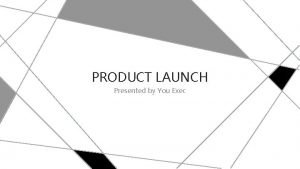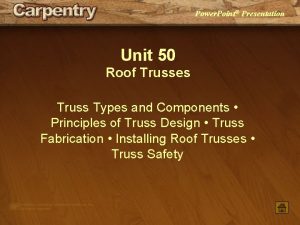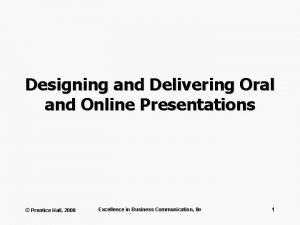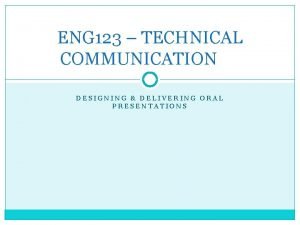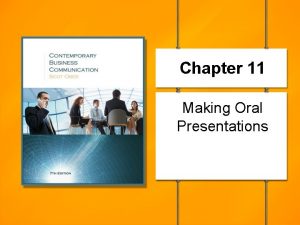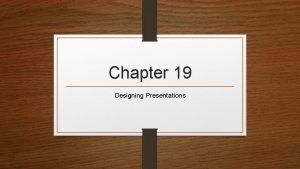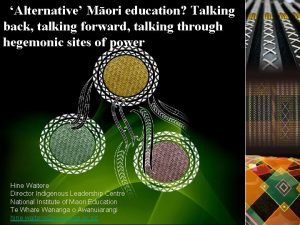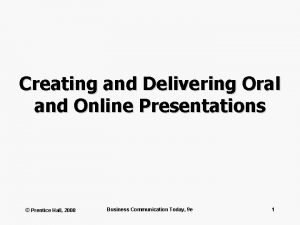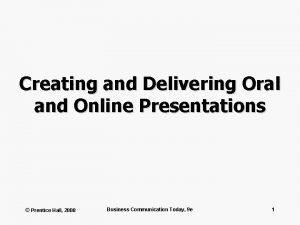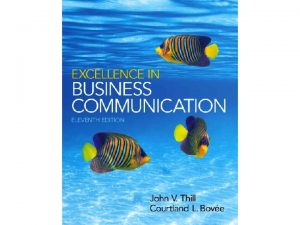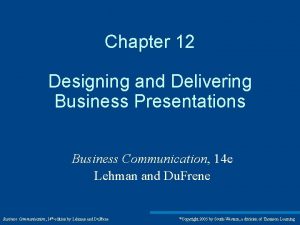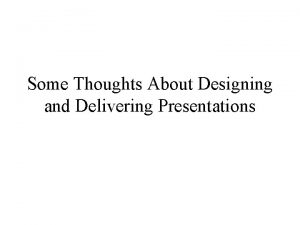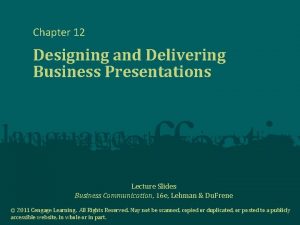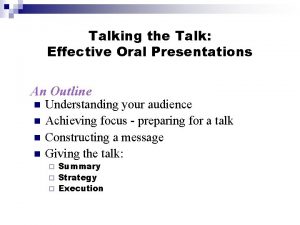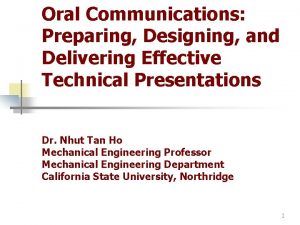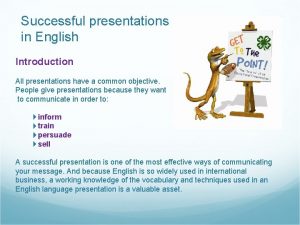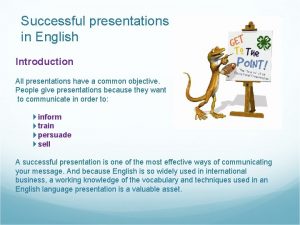Talking Science Designing and delivering successful oral presentations




































- Slides: 36

Talking Science Designing and delivering successful oral presentations Phil Ryan, Ph. D Deputy Director Graduate Programs and Student Services NIH Graduate Partnerships Program, OITE

Scientific objectives of a presentation n Effectively communicate your science Demonstrate your expertise in your scientific area (or your growing expertise) Generate interest in your research ¨ ¨ n You should be excited about what you do You want others to be excited about what you do Encourage potential collaborative opportunities

Professional objectives of a presentation n n Demonstrate your ability to communicate complex science to different types of audiences Establish your reputation as a scientist who understands the details as well as the big picture Promote career building & networking opportunities Get invited to give more talks

Many different types of science talks n Lab meeting presentations Data clubs or interest groups presentation Meeting or conference Academic job talk Chalk talks Industry/private sector job talks General audience or Public talks n “One talk does not fit all!” n n n

Factors in creating an effective talk n n n Knowing your audience Telling an interesting story Defining take home message(s) Presenting good slides with clear meaningful content Staying within the time limit Mastering the Question and Answer period

Science stories have a unique structure Depth of information Beginning Middle End

Good science stories come full circle Depth of information Big Picture Beginning Introduction & Defining the problem Methods & Results Middle End *Big Picture* Conclusions & The Closing

The Beginning n Introduces the topic and presents necessary background ¨ ¨ n Define the problem/question ¨ ¨ n Creates audience buy-in/interest Big Picture – “Why do I care? ” Set the stage for your research Specific focus – “How will this research change things? ” Hypothesis

The Middle n Methodology/Scientific Approach ¨ n Experimental rationale/set up Contains “key” findings or results ¨ ¨ No time for everything A few good pieces of data can tell a big story

The End n Discussion of the results ¨ ¨ ¨ n Brief bullet point slide and/or flow diagram Bring the topic full circle Compare/contrast what you know to before Future directions ¨ ¨ Broad spectrum Not a lot of detail

Good science stories come full circle Depth of information Big Picture Beginning Introduction & Defining the problem Methods & Results Middle End *Big Picture* Time Spent Conclusions & The Closing

Good slides possess… n A title that is a declarative statement ¨ n Figures that are large, clean, and crisp ¨ n n Titles are the take home message Qualitative and quantitative data Minimum amount of text Labels and text that are clearly readable Aids that help identify important information Sufficient white space ¨ Avoid too busy or overwhelming content

Biochemical Analysis N = 23 L 3 4 2 L L 500 Protein (mg/d. L) Trial 1 400 300 200 100 • • • Trial 2 • Ie nhb ibul ition r D T W y D 6 G ru g ud A 4 5 St ild ty pe 0 w L 1 600 50 u. M of study drug with 40 min incubation at 34 o. C Gel electrophoresis Western blot analysis Study drug increases protein expression as opposed to wild type

500 0 I Dnhi eb bi ul tor in HK A 243 576 G ild W ty T pe w Protein Expression (mg/d. L) 17 k. D 7 r to hi bi In HK 23 W T W M HK 237 stimulates protein expression 600 N = 23 400 300 200 100

Mapping your talk and transitions n n Bridges slides to one another Maintain overall flow Slide Take home message Transition language Transition language Slide Take home message

Optimize your slides n Consistent formatting appearance ¨ ¨ n Backgrounds ¨ ¨ n n Succinct chunks of Key “pieces” of information High picture/text ratio Key results ¨ ¨ n White, black, or dark blue Contrasting text Bulleted information ¨ n From slide to slide Titles and text Choosing the best Reformatting it for the audience Effectively emphasize specific information ¨ ¨ Laser pointers versus “hardwired” indicators Avoid custom animation distractions

Optimize your slides n Consistent formatting appearance ¨ ¨ n Backgrounds ¨ ¨ n n Succinct chunks of Key “pieces” of information High picture/text ratio Key results ¨ ¨ n White, black, or dark blue Contrasting text Bulleted information ¨ n From slide to slide Titles and text Choosing the best Reformatting it for the audience Effectively emphasize specific information ¨ ¨ Laser pointers versus “hardwired” indicators Avoid custom animation distractions

Background n n n A specialized endoplasmic reticulum called the sarcoplasmic reticulum (SR) surrounds each myofibril, following the sarcomeric pattern while maintaining an association with the t-tubules. The SR acts as a calcium storage reservoir for the facilitation of muscle contraction through the release of calcium through the calcium release channel. The brain sends an electrical signal along the muscle sheath and down the T-Tubule. This signal initiates calcium release. The binding of calcium within the myofilament arrangement allows for binding between the myofilaments resulting in the sliding of the filaments which is known as contraction. For relaxation, calcium is removed via the sarcoplasmic reticulum’s calcium pump causing the myofilaments to move to their original positions resulting in the relaxation of the muscle

Optimize your slides n Consistent formatting appearance ¨ ¨ n Backgrounds ¨ ¨ n n Succinct chunks of Key “pieces” of information High picture/text ratio Key results ¨ ¨ n White, black, or dark blue Contrasting text Bulleted information ¨ n From slide to slide Titles and text Choosing the best Reformatting it for the audience Effectively emphasize specific information ¨ ¨ Laser pointers versus “hardwired” indicators Avoid custom animation distractions

Muscle contraction is facilitated by Ca 2+

A technique for examining neurotransmitter receptor function at axonal growth cones Perfusion flow 1) Electrophysiology: whole-cell voltage clamp recording from soma 50 mm 2) Apply glutamate receptor agonist to the growth cone by pressure application (100 ms, 4 -6 psi) Perfusion flow Demonstration of the application system: 50 mm -200 ms Pixel intensity (fluorescence): - 400 ms + 600 ms

Optimize your slides n Consistent formatting appearance ¨ ¨ n Backgrounds ¨ ¨ n n Succinct chunks of Key “pieces” of information High picture/text ratio Key results ¨ ¨ n White, black, or dark blue Contrasting text Bulleted information ¨ n From slide to slide Titles and text Choosing the best Reformatting it for the audience Effectively emphasize specific information ¨ ¨ Laser pointers versus “hardwired” indicators Avoid custom animation distractions

Optimize your slides n Consistent formatting appearance ¨ ¨ n Backgrounds ¨ ¨ n n Succinct chunks of Key “pieces” of information Key results ¨ ¨ n White, black, or dark blue Contrasting text High picture/text ratio Bulleted information ¨ n From slide to slide Titles and text Choosing the best Reformatting it for the audience Effectively emphasize specific information ¨ ¨ Laser pointers or other digital pointing/writing device Avoid custom animation distractions

In. D hieb biu tolin r 6 G 2 A 345 7 HK ild W ty p. Te w Protein Expression (mg/d. L) 17 k. D T bi In hi to r HK 23 7 W W M HK 237 stimulates protein expression 600 N = 23 500 400 300 200 100 0

In. D hieb biu tolin r 6 G 2 A 345 7 HK ild W ty p. Te w Protein Expression (mg/d. L) 17 k. D T bi In hi to r HK 23 7 W W M HK 237 stimulates protein expression 600 N = 23 500 400 300 200 100 0

Optimize your slides n Consistent formatting appearance ¨ ¨ n Content ¨ n Succinct chunks of Key “pieces” of information Key results ¨ n White, black, or dark blue Contrasting text High picture/text ratio Bulleted information ¨ n “If you aren’t going to talk about it – don’t have it on the slide” Backgrounds ¨ n From slide to slide Titles and text Only what you need to make the point or tell that particular story Effectively emphasize specific information ¨ ¨ Laser pointers, mouse, digital writing tool, etc. Avoid custom animation distractions

Elements for a successful delivery n Practice is the key ¨ n Tell a story ¨ n n n Avoid shorthand, acronyms, jargon Be engaging and personable ¨ n You’re not just sharing data, you want to make them care Relax, breath and slow your pace Establish a steady audio level Use language appropriate for the audience ¨ n Close to audience type as possible Talk to your audience – eye contact Be enthusiastic about the material

Question and Answers n n n Brief answers; move questions along Make sure you understand what is being asked Repeat the question Practice steering long answers offline OK to say “I don’t know”

The do not’s n n Don’t make last minute changes Don’t put something on a slide you do not intend discussing Don’t include a slide or slides if you expect to skip them Don’t apologize

The do’s n n n Keep your audience in mind at all times Practice early, practice often Prepare for the unexpected Thank those who need to be thanked Recognize work that audience members have done

Preparing for the Three-minute talk n n n Tell them what you want them to know Give them one data slide Wrap it up/Discussion https: //science. nichd. nih. gov/confluence/display/new sletter/2014/03/04/Three-Minute. Talks+Workshop%3 A+Part+I

Tell what you want them to know n n Diagrams/Pictures are your friend What problem are you trying to solve

One data slide n n n What data best represents the problem you are solving Slide should be clean and not too wordy Only show them data that adds to the story, nothing else

Wrap it up n n What is your conclusion Give them context (how does this add to the field)

Tm. T talks for postdocs here at NIH n n Senta: https: //www. youtube. com/watch? v=9 x. Gj. Ys 0 l 4 o Shurjo: https: //www. youtube. com/watch? v=Wa. Ih. QGq. Bihw

More resources at www. training. nih. gov n n n Watch previous OITE career workshops, including many on CVs, resumes and cover letters Connect with me on Linked-In and join the NIH Intramural Science Linked-In group Read the OITE Careers blog Join the OITE NIH Training Alumni database if you are/were a student or fellow here Email me at ryanp@mail. nih. gov
 Designing and delivering oral and online presentation
Designing and delivering oral and online presentation Types of oral presentations
Types of oral presentations It is an art and science of erecting structures
It is an art and science of erecting structures Building and delivering customer value and satisfaction
Building and delivering customer value and satisfaction My favorite subject is science.
My favorite subject is science. Best and worst powerpoint presentations
Best and worst powerpoint presentations The worst powerpoint presentations
The worst powerpoint presentations Manuscript for speech
Manuscript for speech What is an entertainment speech
What is an entertainment speech The craft of scientific presentations
The craft of scientific presentations Titles for mental health presentation
Titles for mental health presentation What are multimedia presentations
What are multimedia presentations Lecture presentations for campbell biology
Lecture presentations for campbell biology Desventajas de corel presentations
Desventajas de corel presentations Verbal support in presentations
Verbal support in presentations Tok presentations
Tok presentations Anna ritchie allan
Anna ritchie allan Ria seminar system
Ria seminar system Boardworks flash
Boardworks flash Pyramid principle
Pyramid principle Internet presentations
Internet presentations The most dangerous game powerpoint
The most dangerous game powerpoint Note card for presentation
Note card for presentation The end pictures for presentations
The end pictures for presentations Useful phrases for presentations
Useful phrases for presentations Efficient elements
Efficient elements Youexec powerpoint template
Youexec powerpoint template Catchy titles for presentations
Catchy titles for presentations Research project title
Research project title Camping merit badge powerpoint
Camping merit badge powerpoint Customer service presentations
Customer service presentations Aironet 3500 presentations
Aironet 3500 presentations Bad powerpoint presentations examples
Bad powerpoint presentations examples Really bad powerpoint
Really bad powerpoint You exec
You exec Roof ppt presentations
Roof ppt presentations Https://creativemarket.com/
Https://creativemarket.com/

